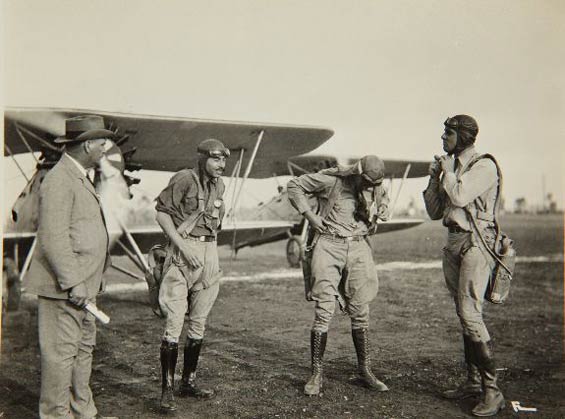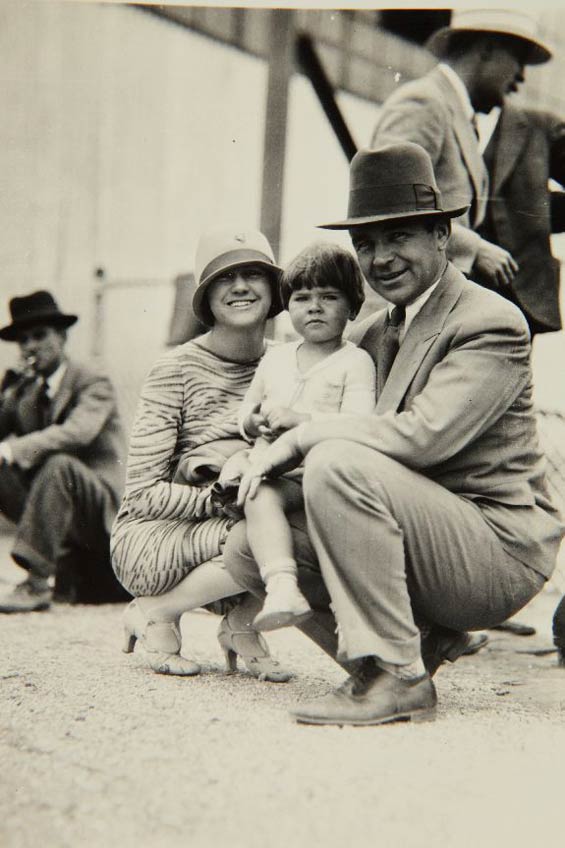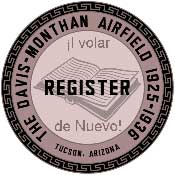|
C.C. Moseley, or "Mose", landed at Tucson once on Sunday, February 26, 1928. He carried his wife and two other passengers (see below) in Fokker NC3908. They were westbound from El Paso, TX to Los Angeles, CA. He noted in the Remarks column of the Register, "The area feels good". Below, from the San Diego Aerospace Museum Flickr Stream (SDAM), is an undated portrait of Moseley.
C.C. Moseley, Date & Location Unknown (Source: SDAM)
 |
C.C. Moseley, Ca. 1932 (Source: BBA, 1932)
 |
Photo, left, from the Blue Book of Aviation cited in the left sidebar. See the Cosgrove Collection on this site for another image of Moseley.
Moseley was born July 23, 1894 in Boise, ID. He was educated at Long Beach, CA high school, and at the University of Southern California, 1914-1917. In 1917 he began his aviation career by enlisting in the School of Military Aeronautics at Berkeley, CA, where he received ground school instruction. He graduated in the top ten and was assigned to immediate service overseas, earning his wings in Tours, France. He was credited with one air victory.
After the Armistice, he remained in France as a test pilot, and was later transferred to Carlstrom Field, Arcadia, FL as Commandant of the Primary Flying School. He then went to Washington, DC on General Billy Mitchell's staff, where he supervised all U.S. Army Air Service schools, then to McCook Field, Dayton, OH, where he was test pilot. In 1920, then major Moseley was winner of the first Pulitzer Air Race.
In 1924 he organized, instructed in, and was the first commanding officer of, the California National Guard, Air Unit, Los Angeles, CA. He resigned from the Army in 1924 and helped organize Western Air Express (WAE) at Los Angeles. He was associated with WAE as vice president and operations manager until February 1, 1929. He then became vice president and western manager for the Curtiss-Wright Airport Corp., and a director of Maddux Airlines.
About this time, February 22, 1929, the new Grand Central Air Terminal (GCAT), Glendale, CA was dedicated. Through a series of negotiations, GCAT became a property of the newly formed Curtiss-Wright Flying Service. Moseley, being a fresh manager with Curtiss-Wright, quickly became, according to Underwood (below), "... the dominant personality at Grand Central and would remain so for nearly four decades." By 1932, Moseley was the manager of the facility.
Moseley was a colorful character on the west coast, well-known for his WWI service and management of the Grand Central Air Terminal during its Golden Age heyday and beyond. His Curtiss-Wright Technical Institute, below, located at GCAT, was a major supplier of aviation technical graduates on the west coast.
Curtiss-Wright Technical Institute, Glendale, CA, 1939 (Source: Site Visitor)
 |
When WWII approached, Moseley became the civilian contractor to organize and operate three different training facilities for Army pilots. These facilities, separated from the Curtiss-Wright Technical Institute, were all located in California at Glendale, Oxnard and Lancaster (trained RAF pilots under lend-lease program). They are described in the Wiener reference in the left sidebar. The link provides a synopsis of the three operations (PDF, 12kb, 2 pages). Below are three photographs that capture Moseley in his capacity as director of these facilities. The first is at Glendale and pictures Register signer General Hap Arnold and cadets with their aircraft.
C.C. Moseley (Facing Camera), Hap Arnold (Shaking Hands) and Cadets, 1939 (Source: Wiener via Woodling)
 |
Below, from the San Diego Aerospace Museum (SDAM) photostream online, courtesy of Bob Woodling, is a photograph of the three Navy pilots known as the "Three Seahawks," an aerobatic exhibition team. The gentleman at left is thought to be General Billy Mitchell, and the location the 1928 National Air Races at Los Angeles. The pilots are, from right, A.P. Storrs, D.W. Tomlinson and W.V. Davis, Jr.
The Three Sea Hawks, 1928 (Source: SDAM via Woodling)
 |
Below, an undated photograph showing Moseley second from right. This photo captures two other Register pilots, Maxwell Balfour at far left, and Claude Ryan in the inset.
Undated Photograph, Moseley Second from Right (Source: Wiener via Woodling)
 |
These books by John Underwood contain references and images of Moseley. Below, a photograph of Moseley, his wife and son. This photo is from the San Diego Aerospace Museum photostream online, courtesy of Bob Woodling. This is an interesting, low-angle composition.
C.C. Moseley, Wife & Son, Date & Location Unknown (Source: SDAM via Woodling)
 |
Moseley's passengers of February 26, 1928 were his wife, above, N.P. (Nelson Paul) Whittier and F.T. (Francis Telford) "Frank" Moonert. Whittier was a pilot who, in just over a year, would touch the lives of two other Register pilots and their aircraft. Whittier served as pilot of the refueling aircraft for Loren Mendell and Pete Reinhart as they flew NR3763, their Buhl CA-5A Angeleno, to a men's landplane endurance record. On July 2-12, 1929, Whittier enabled the Angeleno to remain in the air for 246 hours, 43 minutes and two seconds. The Angeleno was running fine at the end, but was forced down by jammed controls when trash thrown out of the airplane fouled the elevators. Details are in this REFERENCE by Plehinger.
I don't really know what the relationship might have been, but Moseley and Whittier had recently returned to the U.S. from France on February 7, 1928 as documented in an immigration list found at ancestry.com. The airplane they flew in, the Fokker NC3908, was purchased by WAE on February 2, 1928. Now, with Moseley's employment with WAE at the time, Whittier's presence on shipboard, both of them arriving at New York from France on February 7th, and their presence at Tucson a couple of weeks later flying in the Fokker, looks a lot like a ferry flight from the east coast with a new (used) airplane for WAE's fleet. Just a guess.
Regardless, Whittier's obituary, below, from the San Diego (CA) Union of August 23, 1991, describes his life, VIP status and philanthropy.
N.P. Whittier dies oil man, philanthropist
N. Paul Whittier, the fabulously wealthy oil man who gave millions to San Diego for projects as varied as diabetes prevention and yacht restoration, died Wednesday morning at Scripps Memorial Hospital in La Jolla. He was 87.
Whittier was part of a Los Angeles family that owned, with several partners, Belridge Oil Co., which in its 68 years in operation grew rich in oil reserves under 33,000 acres of land near Bakersfield.
In 1979, after a boom in the oil industry, Shell Oil Co. paid the partners $3.65 billion for the business, in what was then the biggest corporate buyout ever. Whittier's personal fortune was estimated three years later by Forbes Magazine at more than $100 million.
Even though he never lived in San Diego, he had many friends in the San Diego and La Jolla social circles. Whittier and his family gave millions -- by one estimate as much as $20 million -- to the San Diego area.
His family spurned publicity and reporters' attempts to gain interviews. But Whittier was often described as a colorful story-teller and adventurer, who learned to fly so early in aviation history that his first airplane license was signed by Orville Wright.
"If we'd written the best script we could have written when we were born, it would have been the one that he lived," said Steve Anderson, a corporate attorney for M.H. Whittier Corp. in South Pasadena, a company which handled family money. Whittier was chairman of the business, whose assets include oil properties in Kern County and other investments, Anderson said.
Whittier had divided his time for the past 30 years between homes in Yucaipa in San Bernardino County and Friday Harbor, Wash. Such was his wealth that, lacking an airstrip to land his private airplane near his Washington home, he built one at Friday Harbor and allowed others to use it, friends said yesterday.
The cause of his death was not revealed, but he had suffered from cancer, Anderson said.
Many of the Whittier family's San Diego gifts were to the La Jolla hospital where he died yesterday. Whittier's first wife, Olive, had diabetes and also died there in 1976.
In 1980, Whittier gave $5 million to Scripps Memorial to start the Whittier Institute for Diabetes and Endocrinology. Its scientific and executive director, Willard P. VanderLaan, had been Olive Whittier's personal physician for many years before her death.
VanderLaan, in a statement through the hospital, remembered Whittier yesterday as "a doer. He had a zest for living and made so many great accomplishments." VanderLaan also recalled Whittier's sensitivity to people in trouble: "He couldn't see someone in distress without being moved by it."
Whittier introduced other family members to Scripps Memorial, and with them they brought more donations: a $2.5 million gift for the Lucy Thorne Whittier Children's Center for research and treatment of juvenile diabetes; $4 million for the Mericos Eye Institute. A sister, the late Helen Woodward, lived in Del Mar for many years.
The Whittiers also contributed to the Zoological Society of San Diego, helping to create the Southeast Asia "Heart of the Zoo" project. Other major gifts went to Scripps Clinic and Research Foundation for a research endowment, the Helen Woodward Animal Care and Education Center, and the Aerospace Museum library and archives.
Whittier was an avid sailor, and some friends said yesterday his relationship with San Diego owed a lot to Joe Jessop, a San Diego businessman and fellow yachtsman. "We met when (the Whittier family) came down with their yacht," Jessop said yesterday. That was in 1924, and Jessop and Whittier became lifelong friends. "Paul Whittier left a trail of wonderful things wherever he went," Jessop said through the hospital. "No matter where he was he always got involved and made things better because of it."
In 1971, on a trip to Sweden, Whittier came upon the Medea, a Victorian-era steam yacht that had been caught in a cocoon of ice and snow and badly damaged. He restored it for more than $300,000, and two years later donated it to San Diego's Maritime Museum Association, which also operates the Star of India and the ferryboat Berkeley. The Medea is now moored off Harbor Drive, one of only a few yachts of its kind still afloat. ...
|
Passenger Moonert (b. Cincinnati, OH, 1902) was a mechanic and flight test observer, very well-known among early pilots and manufacturers. His work is summarized in a few articles from Ryan company magazines. The articles are at the link (PDF, 12kb, 2 pages).
---o0o---
THIS PAGE UPLOADED: 02/03/10 REVISED: 04/09/12, 04/28/14, 12/01/14
|








